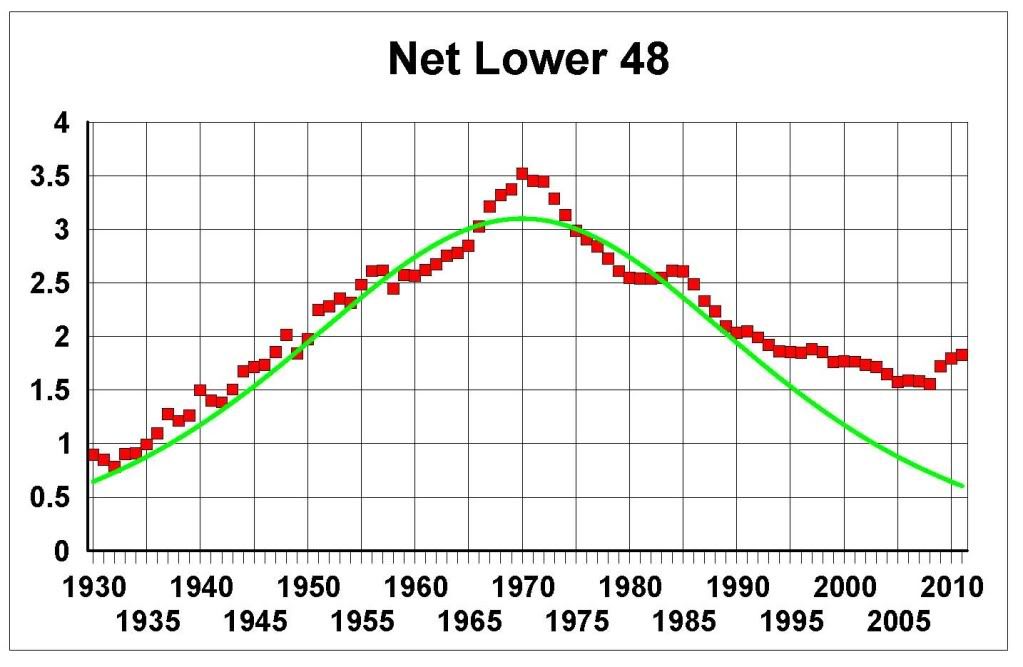Here's US oil production:

We see that the curve isn't symmetric: it rises a bit in 1985, drifts lower, then starts clearly rising in 2009.
Here's oil prices:
http://www.wtrg.com/prices.htm
This illustrates an important assumption in the Hubbert model: substitution. Hubbert drew his model from his experience with individual oil fields, where depletion of the field wouldn't affect the overall market for oil. The US as a whole is larger, but when oil production in the US peaked, it could still import oil, so prices didn't rise.
Of course, it's a little more complicated: world prices rose due to the oil embargo in 1973, but price increases in the US were suppressed by price controls. Then the Iran debacle raised them in 1979, and we started to see a response by 1985, but then prices fell again. Price feedback didn't happen again until 2005 when world prices started rising - then US lower 48 production started rising again (with a several year lag).
Could this just be random variation?
Well, we have to account for 2M bpd from Bakken-type oil shale. That level of production isn't a sure thing, but it's pretty likely. If it happens, that's definitely not going to fit into random variation of a Hubbert type bell-shaped curve.
Again, the increase from the Bakken (and other fields like it, like the Eagle Ford and the Niobrara) is not due to random variation in discovery. The Bakken increase is due to a change in technology/techniques/engineering - the field has been known for decades, but up to 400B barrels have been out of reach until lately (That's the total theoretical resource. The official estimate of recoverable oil was about .1% of that up to about 3 years ago, then it went to about 1%. Now we're seeing industry estimates of 24B being recoverable - a 6x increase over just 3 years ago).
A Hubbert Linearization of the Lower 48 (using only production data through 1970) showed estimated URR of about 200 Gb, through 1970 the Lower 48 had produced about 100 Gb. Doesn't that suggest that it's unlikely that the Lower 48 will produce much more than another 100GB?
Well, the Lower 48 produced 91.3 Gb from 1971 through 2011, and production is at 1.8Gb per year and rising. I'd say it's pretty clear we'll exceed 100 GB post-1970 by a wide margin.
Will these shale plays will make a really material difference?
The latest estimate is for about another 24 GB from the Bakken alone. "Production results for the Bakken formation in the Williston basin continue to improve with technological advances, prompting Continental Resources Inc. to estimate potentially recoverable reserves of 24 billion boe." http://www.ogj.com/index/article-display.articles.oil-gas-journal.volume-109.issue-23.general-interest.focus-unconventional-oil-gas-sliding-sleeve-fracs.html.html
The Eagle Ford is also important: The Eagle Ford is also important: "With the Eagle Ford Shale alone now expected to eventually deliver 750,000 to 800,000 b/d of oil, industry leaders repeated their growing enthusiasm Monday for a newfound focus on US oil plays over natural gas."
http://www.platts.com/RSSFeedDetailedNews/RSSFeed/Oil/6162878
It seems to me that analysis of our historical experience leaves out two key things: technical change, and price feedback.
Much of our historical experience is based on periods where there wasn't a great deal of technical change, and on a field-by-field and country-by-country analysis, where depletion doesn't cause a price signal feedback. In our current situation we have permanently high prices, which is a new thing. As a result, US production is increasing, and that increase appears likely to continue for a while.
I wouldn't want US domestic drilling to distract from the important thing, which is kicking the addiction to oil - the more we do so, the better off we'll be, in many, many ways. OTOH, we have to be realistic: US production is looking less and less like a Hubbert peak shape, and on the whole that's probably good.